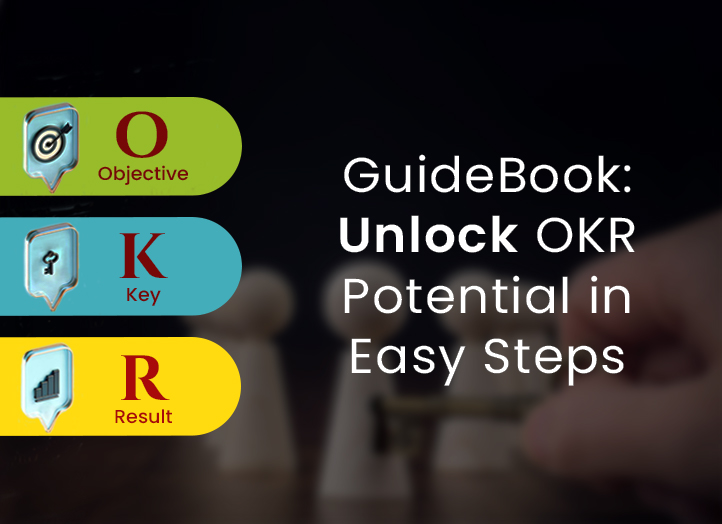
Guidebook: Unlock OKR Potential in Easy Steps
Master the OKR Concept: A Comprehensive Guide to Objectives and Key Results for Exponential Business Growth
Table of Contents:
- Introduction to OKR
- Understanding OKR Framework
- Benefits of Implementing OKRs
- Creating Effective OKRs
- OKR Implementation: A Step-by-Step Guide
- Best Practices for OKR Success
- Tools and Software for OKR Management
- Common Challenges and How to Overcome Them
- OKRs in Different Industries
- Case Studies of Successful OKR Implementation
- Future Trends in OKR
- Conclusion
1) Introduction to OKR:
What is OKR?
Objectives and Key Results (OKR) is a goal-setting framework that helps organizations define and track objectives and their outcomes. It promotes clarity, alignment, and engagement by linking company, team, and individual goals.
History and Origins of OKR
OKR was popularized by Andy Grove at Intel in the 1970s. John Doerr, a venture capitalist who learned the framework from Grove, later introduced OKRs to Google, where it became a cornerstone of the company’s success.
Importance of OKR in Business
OKRs are essential for driving focus, accountability, and measurable results. They enable companies to align their efforts towards common goals, ensure everyone is moving in the same direction, and measure progress effectively.
2) Understanding OKR Framework:
The Anatomy of OKRs
OKRs consist of two main components:
- Objectives: Clearly defined goals that describe what you want to achieve.
- Key Results: Specific, measurable outcomes that indicate when the objective has been met.
Setting Objectives
Objectives should be ambitious, qualitative, and time-bound. They should inspire and challenge the team to push beyond their comfort zones.
Defining Key Results
Key Results are quantifiable and time-bound metrics used to measure progress towards achieving the objective. They should be specific, achievable, and trackable.
The OKR Cycle
The OKR cycle typically follows a quarterly cadence, including setting OKRs, tracking progress, and reviewing outcomes. This cycle promotes continuous improvement and adaptability.
3) Benefits of Implementing OKRs:
Alignment and Focus
OKRs ensure that everyone in the organization is working towards the same goals, creating a unified direction and preventing misalignment.
Enhanced Performance and Accountability
OKRs provide clear expectations and measurable outcomes, promoting accountability and high organizational performance.
Increased Transparency
By making OKRs visible to the entire organization, companies foster a culture of openness and transparency, which enhances trust and collaboration.
Encouraging Innovation
The ambitious nature of OKRs encourages teams to think creatively and explore new solutions, driving innovation and growth.
4) Creating Effective OKRs
Setting SMART Objectives
Objectives should be Specific, Measurable, Achievable, Relevant, and Time-bound (SMART). This ensures they are clear and actionable.
Developing Measurable Key Results
Key Results should be quantifiable and include metrics that reflect progress toward the objective. Examples include revenue targets, user engagement metrics, and project milestones.
Balancing Ambitious and Realistic Goals
OKRs should strike a balance between being challenging and achievable. Ambitious goals drive performance, while realistic targets prevent demotivation.
Example of Effective OKRs:
Objective: Increase customer satisfaction.
Key Results:
– Achieve a Net Promoter Score (NPS) of 60+.
– Reduce customer support response time to under 2 hours.
– Increase positive customer reviews by 20%.
5) OKR Implementation: A Step-by-Step Guide:
Preparing for OKR Adoption
- Understand the Framework: Ensure leadership and key stakeholders understand the OKR framework.
- Assess Readiness: Evaluate organizational readiness for adopting OKRs.
- Plan Rollout: Develop a detailed plan for introducing OKRs.
Communicating OKR Framework to Your Team
Clearly explain the benefits of OKRs, how they work, and the expectations for using them. Provide training and resources to help teams get started.
Setting Company-Wide OKRs
Start by defining top-level objectives that align with the company’s mission and vision. These objectives should set the direction for all other OKRs.
Cascading OKRs to Teams and Individuals
Ensure that team and individual OKRs align with company-wide objectives. This cascading process ensures alignment and focus across all levels of the organization.
Tracking Progress and Reviewing OKRs
Regularly review OKRs to track progress and make necessary adjustments. Use OKR software tools to facilitate tracking and reporting.
6) Best Practices for OKR Success:
Maintaining Flexibility
While OKRs provide structure, it’s important to remain flexible and adapt to changes. Adjust OKRs as needed to reflect shifting priorities and circumstances.
Encouraging Regular Check-Ins
Regular check-ins (weekly or bi-weekly) help teams stay on track, address challenges, and celebrate progress. These meetings should be brief and focused on key updates.
Fostering a Culture of Feedback
Encourage open and constructive feedback throughout the OKR process. This helps teams improve and fosters a culture of continuous learning and growth.
Celebrating Successes and Learning from Failures
Recognize and celebrate achievements to motivate teams. Additionally, view setbacks as learning opportunities and make necessary adjustments.
7) Tools and Software for OKR Management:
Overview of Popular OKR Tools
– Weekdone: A simple OKR tracking tool that offers progress reports and team feedback.
– Gtmhub: Provides integration with various data sources and advanced analytics.
– Koan: Focuses on collaboration and continuous reflection.
– WorkBoard: Offers comprehensive OKR management and business insights.
How to Choose the Right Tool
Consider factors such as ease of use, integration capabilities, scalability, and cost. Choose a tool that aligns with your organization’s needs and workflows.
Integrating OKR Tools into Your Workflow
Ensure that the chosen tool integrates seamlessly with your existing systems and processes. Provide training and support to ensure smooth adoption and usage.
8) Common Challenges and How to Overcome Them:
Setting Unrealistic Objectives
Avoid setting objectives that are too ambitious or unattainable. Ensure objectives are challenging yet achievable to maintain motivation and focus.
Lack of Alignment and Buy-In
Ensure that all team members understand and buy into the OKR process. Communicate the benefits and provide training to foster alignment and commitment.
Poor Tracking and Follow-Up
Regularly track progress and conduct check-ins to ensure OKRs remain relevant and on track. Use OKR tools to facilitate tracking and reporting.
Resistance to Change
Address resistance by clearly communicating the benefits of OKRs and involving employees in the process. Provide support and resources to ease the transition.
9) OKRs in Different Industries:
Technology and Software Development
In tech and software, OKRs drive innovation and rapid iteration. Objectives might focus on product development, user engagement, and technical excellence.
Marketing and Sales
Marketing and sales teams use OKRs to align efforts on customer acquisition, brand awareness, and revenue growth. Key results often include lead generation metrics and conversion rates.
Human Resources and Employee Development
HR teams leverage OKRs for talent acquisition, employee engagement, and development programs. Objectives might include improving employee satisfaction or reducing turnover rates.
Non-Profits and NGOs
Non-profits use OKRs to amplify their impact, focusing on fundraising goals, program outreach, and volunteer engagement. Key results might track donation amounts or community involvement.
10) Case Studies of Successful:
OKR Implementation
Google: The Pioneer of OKRs
Google’s adoption of OKRs has driven significant growth and innovation. Their success story highlights the importance of ambitious objectives and transparent key results.
LinkedIn: Driving Growth with OKRs
LinkedIn uses OKRs to align its global teams and drive user engagement. Their focus on measurable outcomes has led to significant improvements in user growth and platform features.
Intel: Innovation Through OKRs
Intel, the birthplace of OKRs, uses the framework to foster a culture of innovation and continuous improvement. Their approach has led to ground breaking advancements in technology.
Non-Profit Sector: Amplifying Impact with OKRs
Many non-profits use OKRs to streamline their efforts and maximize their impact. By focusing on clear objectives and measurable results, they achieve greater success in their missions.
11) Future Trends in OKR:
The Role of AI and Machine Learning in OKR
AI and machine learning are transforming OKR management by providing predictive analytics, automating progress tracking, and offering data-driven insights.
Personal OKRs: Applying the Framework Beyond Business
Individuals are increasingly adopting OKRs for personal development, setting goals related to health, education, and personal growth.
The Evolution of OKR Methodologies
The OKR framework continues to evolve, incorporating new methodologies and best practices to enhance its effectiveness and adaptability in various contexts.
12) Conclusion:
Recap of Key Points
OKRs are a powerful tool for driving focus, alignment, and measurable results. By setting clear objectives and key results, organizations can achieve their goals more effectively.
The Continuous Journey of OKR
OKR is not a one-time initiative but a continuous process that requires ongoing attention, adaptation, and improvement. Embrace the journey to unlock its full potential.
Final Tips for Sustaining OKR Success
– Regularly review and adjust OKRs to reflect changing priorities.
– Foster a culture of feedback and continuous improvement.
– Celebrate successes and learn from failures to keep teams motivated.
By mastering the OKR framework, you can drive meaningful progress, foster alignment, and achieve your strategic goals.


